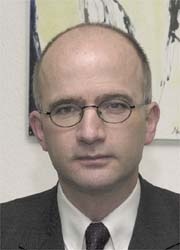50 years of open heart surgery
By Professor Hans-Joachim Schaefers, Department of Thoracic, Cardiac and Vascular Surgery, University Hospital Saarland
Fifty years ago Henry Gibbon introduced a vital tool for cardiac surgery - the heart-lung machine. While pioneering efforts were made in the first half of the 20th century, this equipment enabled reproducible operations for either congenital or acquired heart disease in many patients.

Between 1953 and 1980 the ground was laid for most of the treatment principles still used in modern cardiac surgery.
Today cardiac surgery can help, or even cure, almost all congenital heart defects, and even correct or effectively stabilise complex defects in the first few days of life, with low mortality and good functional results. Congenital or acquired functional defects of heart valves can be repaired or treated by valve replacement for infants to octogenarians, with marked improvement of prognosis and exercise ability.
Replacement of the aorta for aneurysm or dissection can be performed using synthetic grafts with relatively low risk, and, if necessary, the whole aorta can be replaced. The treatment of coronary artery disease by bypass surgery boomed in the 1980s and 1990s. With the ever-increasing prevalence of this disease, prophylactic operations to improve myocardial blood flow currently play the biggest role in cardiac surgery. Most treatment principles in these areas have remained relatively constant over the past 20 years. Nonetheless, further improvement of results can be anticipated from the gradual modifications made, such as extending the possibilities of valve repair, improving the long-term prognosis in heart valve substitutes or the predominant use of arterial grafts in coronary surgery.
Some changes that have arisen in the past decade that may or may not play an important role in cardiovascular medicine in 2010. Minimally invasive surgery has been introduced successfully into surgical specialities, such as general surgery, gynaecology and urology. This has also been introduced to cardiac surgery to minimise trauma. Presently, technical details are not the only subject of controversial discussion. It is also unclear whether minimally invasive surgery can attain the goal of being less traumatic, without compromising functional results in cardiac surgery. Along similar lines, coronary surgery without using cardiopulmonary bypass (of the ‘pump’) has been proposed - to minimise potential neurologic complications. Similarly, its effect has not been clearly confirmed and is the subject of controversial discussion.
Currently major challenges to cardiac surgery from a medical perspective come not from the discipline itself but from cardiology. With increased efforts in preventive medicine and the use of lipid-lowering drugs, the prevalence of coronary artery disease is expected to decrease substantially. Interventional cardiology is treating an increasing number of patients by angioplasty, and it is unclear whether advances in interventional treatment - such as drug eluting stents - will effectively reduce the need for surgical treatment. However, the time is also right to look closely at the cost effectiveness of interventional versus surgical treatment. As yet no good analyses are available, and whether it is reasonable and cost-effective to more patients who have had four, five or more coronary interventions before ultimately having surgery, remains to be shown
Other socio-economic factors can be anticipated to have basic effects on medicine in general as well as cardiac surgery. Healthcare’s increasing cost (caused by the increasing age of the European population and increased availability of treatment options) is placing strong economic pressure on healthcare in general, to which different countries have reacted differently. Irrespective of national differences, the economic pressure will increase and will affect medical practice.
It can also influence medical evolution or progress. Not only will new technologies, such as robotic surgery, need scrutiny regarding their efficacy compared with more conventional techniques, but the question arises as to whether and to what degree a new technology leads to an increase in cost without concomitant increase in quality of healthcare.
In recent years, a new aspect has come on the scene with particularly strong implications for cardiac surgery. Traditionally, this discipline is characterised by a high percentage of unplanned, i.e. emergency operations and relatively long operating times. During postoperative patient care, close follow-up of patients has been essential, to prevent or aggressively treat potential complications that could be life threatening. The empirical nature of cardiac surgery also requires exposure to a wide variety of situations, during training periods as well as subsequent practice in the profession. Despite the workload and pressure on individual surgeons, cardiac surgery has always drawn interested and ambitious individuals due to its fascination. With the advent of close regulation of working schedules, this system is now substantially challenged. While nobody will argue that an 80-hour week is good for a surgeon or patient, who must be treated during evening hours (when concentration is far from optimal), current trends challenge traditional aspects of quality of care - particularly the continuity of care. Different solutions may be implemented to alleviate the current conflict of interests, but advantages as well as disadvantages of different approaches will have to be carefully weighed in the future.
Over the past 50 years, cardiac surgery has evolved from a clinical experiment to a formally established clinical speciality that can offer prolongation of life expectancy and improved quality of life to many patients in a very wide range of ages. At the beginning of the new millennium this young speciality will have to deal with new challenges, and it is at this point difficult, if not impossible, to predict future development.
01.07.2003










